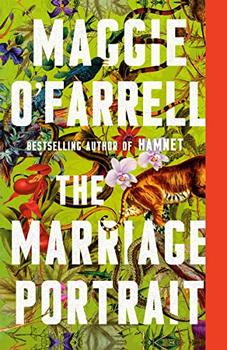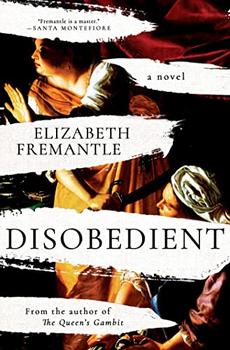Summary | Excerpt | Reading Guide | Reviews | Beyond the book | Read-Alikes | Genres & Themes | Author Bio

A novel
by Maggie O'FarrellThe idea of marrying for love is a startlingly recent development. It seems natural, in our society that has built stories, movies and an entire wedding industry around the idea that marriage is an expression of true love. But in earlier centuries, marriage was a political and economic arrangement with love considered, at best, a happy accident, and as Maggie O'Farrell shows in her historical novel The Marriage Portrait, those arrangements could have fatal consequences for wives.
O'Farrell brings to life early modern Italy while also masterfully inhabiting the mind of a bright yet awkward girl. The lead character and object of the portrait in the title is Lucrezia de' Medici, an actual daughter of Cosimo I de' Medici, Grand Duke of Tuscany, who is believed to have been born in 1545. O'Farrell presents an alternate telling of the life of this obscure yet tragic character from Renaissance history.
The book begins with Lucrezia's realization that her husband means to murder her while they're at a remote castle. The story then loops back through her childhood and adolescence, with chapters periodically jumping to her in the castle trying to avoid her husband's violent intentions. This structure lets the reader watch Lucrezia grow from a smart, artistically gifted girl into a perceptive young woman.
Lucrezia's happy childhood is upended when her eldest sister, who was betrothed to Alfonso II d'Este, Duke of Ferrara, suddenly dies, and the duke requests Lucrezia's hand instead. O'Farrell's attention to detail and historical accuracy are outstanding, from the names of Cosimo's advisors to Alfonso's family history, and she crafts his contradictory character skillfully.
Lucrezia is terrified of marriage and leaving home, particularly since she is barely a teenager when she marries Alfonso, who is in his mid-20s. At first, however, her husband seems caring and kind. Alfonso indulges Lucrezia's love of animals and painting, and he betrays no disappointment in marrying the quiet and bookish girl rather than her older, more glamorous sister.
Yet warning signs appear almost immediately — that beneath his calm exterior, Alfonso is a cruel and vindictive man; that his political position is tenuous and he'll kill to maintain it; that the people surrounding Lucrezia are using her for their own ends.
Alfonso and Lucrezia soon travel to the city-state of Ferrara in northern Italy, the seat of his power. Yet Alfonso's mother, a Protestant refusing to practice Catholicism, has caused chaos by fleeing to France along with one of her daughters. With no heir to guarantee succession and his mother and sister politically protected in France, Alfonso runs the risk of being replaced by his sister's child, which would allow his mother, sister and their faction of the family to gain power.
Alfonso's other sisters who stay in Ferrara quickly pull Lucrezia into their power politics, but she learns that their acts of friendship are insincere. She also realizes that only by providing Alfonso with an heir can she ensure her own safety. Her role as a wife is to guarantee that the dynasty continues, and Alfonso is not a man to let feelings interfere with that fact.
But the heir doesn't come — and everyone at court knows Alfonso has never even fathered a bastard out of wedlock. As a result, rumors swirl that he can't safeguard the succession. All the while, Alfonso's chosen artists are working on a portrait of Lucrezia, a beautiful work that mirrors her own love of painting yet begins to take on a life of its own. O'Farrell correctly depicts how master artists worked in groups during the Renaissance, with apprentices and assistants handling different aspects of sketching and painting a commission like this one. Lucrezia's sessions with the artists become one of her few outlets in an increasingly claustrophobic life at court.
Alfonso's attempts to impregnate his wife grow more fervent, with medieval doctors prescribing cures and barring Lucrezia from her only joys, painting and exploring the castle. His anger with his sisters becomes more violent, as does his frustration with the still-childless Lucrezia, and she finally understands that not giving birth to an heir will be her downfall.
As the story builds, O'Farrell circles back to where the novel began, with Lucrezia at the castle, cognizant that Alfonso wants to murder her. The pace of the two timelines crescendos perfectly, coming together in the terrifying yet exhilarating resolution that brings together Alfonso, Lucrezia and the artists and courtiers around them.
This structure gives the book the feel of a murder mystery — Will he or won't he do it? What is he capable of? — and the simmering undercurrents of danger draw the reader in, enveloping us in Lucrezia's fear and confusion, but also her intelligence and bravery. At the same time, O'Farrell's historical accuracy avoids dryness, and while she takes some artistic liberties with the actual biography of Lucrezia de Medici, her depiction of life in 16th-century Florence and Ferrara are lively and colorful, made real for a 21st-century audience.
By shortening the distance between Lucrezia's lifetime and our own, O'Farrell also makes the risks of succession and reproduction patently clear for modern readers. She provides a glimpse of the terror, pride, hope, danger and sometimes affection that marriage entailed for early modern women, all within an exciting and fast-paced tale.
![]() This review was originally published in The BookBrowse Review in October 2022, and has been updated for the
August 2023 edition.
Click here to go to this issue.
This review was originally published in The BookBrowse Review in October 2022, and has been updated for the
August 2023 edition.
Click here to go to this issue.

If you liked The Marriage Portrait, try these:

by Jo Harkin
Published 2025
A sweeping historical novel in the vein of Hilary Mantel and Maggie O'Farrell set during the time of the Tudors' ascent. The Pretender tells the story of Lambert Simnel, who was raised in obscurity as a peasant boy to protect his safety, believed to be the heir to the throne occupied by Richard III, and briefly crowned, at the age of ten, as King ...

by Elizabeth Fremantle
Published 2023
A riveting novel based on the life of Artemisia Gentileschi—the greatest female painter of the Renaissance—as she forges her own destiny in a world dominated by the will of men.
Your guide toexceptional books
BookBrowse seeks out and recommends the best in contemporary fiction and nonfiction—books that not only engage and entertain but also deepen our understanding of ourselves and the world around us.